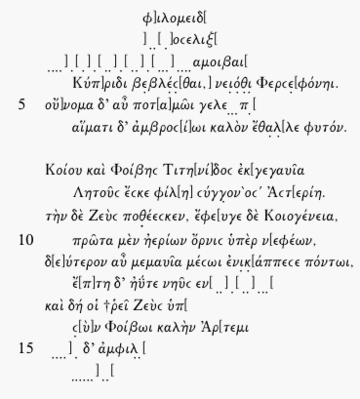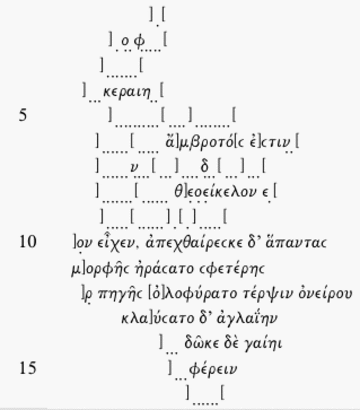New Light on the Narcissus Myth
P.Oxy. LXIX 4711
By W. B. Henry
One of the most interesting of the new literary fragments published in Volume LXIX of The Oxyrhynchus Papyri (2005) is a set of brief mythological narratives in Greek elegiac couplets. The subjects are Narcissus, Adonis, and Asteria (the nymph who became the island of Delos). Each of the three fragmentary narratives features metamorphosis prominently, and the editor, W. B. Henry, has suggested that the fragment may belong to the Metamorphoses by Parthenius of Nicaea. G. O. Hutchinson, 'The Metamorphosis of Metamorphosis: P. Oxy. 4711 and Ovid', Zeitschrift für Papyrologie und Epigraphik 155 (2006) 71–84, considers the attribution plausible.
Of particular interest is the poet's treatment of the Narcissus story, poetic accounts of which are very rare. The myth is first attested around the turn of the first century AD. It turns up famously in Ovid's Latin epic, the Metamorphoses (3.339–510). There is also a less well-known Greek account in a collection of stories in prose (Διηγήσεις) composed by one Conon about the same time, and preserved in epitome form. If our version is by Parthenius, it has a special importance. Parthenius came to Rome after being captured in the third Mithridatic War, perhaps in 73 BC. He was a very influential figure among the poets of the time, and Ovid would almost certainly have read his account of the myth before composing his own.
Here are a reconstructed text and English translation of the fragment; for images of the papyrus, click here. The order of the two sides (↓, with the papyrus fibres running vertically, and →, with the papyrus fibres running horizontally) is not known. Conjectural supplements are enclosed in square brackets in the Greek; `´ indicates an addition above the line, † a corrupt word. Dots indicate uncertainly read or (in gaps) missing letters.
↓

... laughter-loving1 ... (ADONIS concluded)
... wheeling (?)2 ...
... alternately
A care to Cypris, and below to Persephone.3
And his name to a river4 ...
And with his deathless blood there bloomed a lovely plant.5
Daughter of Coeus and Phoebe the Titaness, (ASTERIA)
Leto's dear sister was Asteria.
And Zeus desired her; Coeus' daughter fled from him,
First as a bird6 above the airy clouds;
Second, she jumped determinedly into mid-sea
And flew just like a ship among the waves.7
And Cronus' son8 placed under her pillars for roots
When he begot fair Artemis with Phoebus
1 A common epithet of Aphrodite.
2 Perhaps of the boar that killed Adonis on a hunt (Ovid, Metamorphoses 10.710–16).
3 Adonis spent part of the year with Cypris (= Aphrodite) and part with Persephone (so e.g. Apollodorus 3.14.4).
4 Adonis gave his name to the river of Byblos.
5 Similarly Ovid, Metamorphoses 10.735 flos de sanguine concolor ortus, 'a flower of the same colour grew from his blood'.
6 A quail (so Apollodorus 1.4.1).
7 Asteria became a floating island for a time. She was fixed to the spot (as Delos) when she became the birthplace of Artemis and Apollo, children of Zeus and Leto. Compare e.g. Callimachus, Hymn 4.51–4.
8 Zeus.
→

(NARCISSUS)
... god-like ...
... ...
He had a cruel heart, and hated all of them,
Till he conceived a love for his own form:
He wailed, seeing his face, delightful as a dream,
Within a spring; he wept for his beauty.
Then the boy shed his blood and gave it to the earth
... to bear
The new version of the Narcissus story is much more concise than Ovid's. Ovid devotes many verses to the nymph Echo, who in her unrequited love for Narcissus wastes away until only an echo remains: she can only repeat what others say. There is no trace of her either in the papyrus text or in Conon's account. There, Narcissus is a young boy and his lovers are all male. Ovid also distinguishes himself from the other two authors by having Narcissus, like Echo, simply waste away. His body mysteriously disappears, and when the nymphs come to collect it, they find the flower in its place. In Conon's version, as in the new papyrus, the boy kills himself. It is his blood that produces the narcissus flower. (In this respect, the story resembles that of Adonis, told on the other side of the papyrus fragment.) In the light of the new evidence, it seems that Ovid may well have been the first to give the myth its now familiar form.


